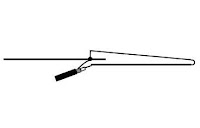It failed on 3 counts (high pitch, low volume and interrupted carrier) resulting in a very poor-quality signal.
Hence a bit of design effort was called for. The result is the following schematic.
 |
| HT-powered CW Interface - Schematic |
Oscillation is obtained using an AC128 (Germanium PNP AF transistor) and an audio transformer with a turns ratio of 1:5.
The 220K and 4.7K trimpots enable adjustment for the desired tone without motorboating.
In the event of the circuit failing to oscillate, connections to one of the transformer windings is reversed.
Connection to the microphone jack is through a shielded cable.
 |
| HT-powered CW Interface Board |
The unit was tested/adjusted while monitoring the signal with another rig. 100% modulation, with a clean note, was obtained.
Use of a homebrew electronic keyer precluded the need for a sidetone monitor.
It was an interesting weekend project using parts from the junk box.
______________________________



